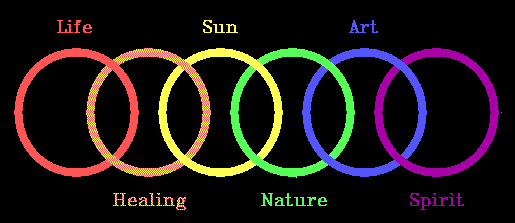"The Rainbow Flag" by Steven W. Anderson GAZE Magazine (Minneapolis), #191, 28 May 1993, p. 25
Color has long played an important role in our community's expression of pride. In Victorian England, for example, the color green was associated with homosexuality. The color purple (or, more accurately, lavender) became popularized as a symbol for pride in the late 1960's - a frequent post-Stonewall catchword for the gay community was "Purple Power". And, of course, there's the pink triangle. Although it was first used in Nazi Germany to identify gay males in concentration camps, the pink triangle only received widespread use as a gay pop icon in the early 1980's. But the most colorful of our symbols is the Rainbow Flag, and its rainbow of colors - red, orange, yellow, green, blue and purple - represents the diversity of our community.
The first Rainbow Flag was designed in 1978 by Gilbert Baker, a San Francisco artist, who created the flag in response to a local activist's call for the need of a community symbol. (This was before the pink triangle was popularly used as a symbol of pride.) Using the five-striped "Flag of the Race" as his inspiration, Baker designed a flag with eight stripes: pink, red, orange, yellow, green, blue, indigo and violet. According to Baker, those colors represented, respectively: sexuality, life, healing, sun, nature, art, harmony and Spirit. Baker dyed and sewed the material for the first flag himself - in the true spirit of Betsy Ross.
Baker soon approached San Francisco's Paramount Flag Company about mass-producing and selling his "gay flag". Unfortunately, Baker had hand-dyed all the colors, and since the color "hot pink" was not commercially available, mass production of his eight-striped version became impossible. The flag was thus reduced to seven stripes.
In November of 1978, San Francisco's gay community was stunned when the city's first openly gay supervisor, Harvey Milk, was assassinated. Wishing to demonstrate the gay community's strength and solidarity in the aftermath of this trajedy, the 1979 Pride Parade Committee decided to use Baker's flag. The committee eliminated the indigo stripe so they could divide the colors evenly along the parade route - three colors on one side of the street and three on the other. Soon the six colors were incorporated into a six-striped version that became popularized and that, today, is recognized by the International Congress of Flag Makers.
In San Francisco, the Rainbow Flag is everywhere: it can be seen hanging from apartment windows throughout the city (most notably in the Castro district), local bars frequently display the flag, and Rainbow Flag banners are hung from lampposts on Market Street (San Francisco's main avenue) throughout Pride Month. Visiting the city, one cannot help but feel a tremendous sense of pride at seeing this powerful symbol displayed so prominently.
Although the Rainbow Flag was initially used as a symbol of pride only in San Francisco, it has received increased visibility in recent years. Today, it is a frequent sight in a number of other cities as well - New York, West Hollywood and Amsterdam among them. Even in the Twin Cities, the flag seems to be gaining in popularity. Indeed, the Rainbow Flag reminds us that ours is a diverse community - composed of people with a variety of individual tastes of which we should all be proud.

The wearing of the Pink Triangle stems from the Holocaust. You may remember that the Jews were forced to wear yellow Stars of David on their sleeves to alert everyone to their status as Jews. You may not be aware that the Stars of David were not the only symbol that people were forced to wear. Gay men were forced to wear the Pink Triangle, and Lesbians, prostitutes, and other "socially undesirable" women were forced to wear a black triangle.
While it is most common for the Pink Triangle to be associated with the Gay and Lesbian movement, the Black Triangle has been adopted, because of its history, by many lesbians.

More Man Than You'll Ever Be: Gay Folklore and Acculturation in Middle America (Indianapolis: Indiana University Press, 1989), p. 26 by Joseph P. Goodwin
"The lowercase Greek letter, lambda, carries several meanings. First of all, it represents scales, and thus balance. The Greeks considered balance to be the constant adjustment necessary to keep opposing forces from overcoming each other. The hook at the bottom of the right leg of the lambda represents the action required to reach and maintain balance. To the Spartans, the Lambda meant unity. They felt that society should never infringe on anyone's individuality and freedom. The Romans adopted the letter to represent the light of knowledge shed into the darkness of ignorance. Finally, in physics the symbol designates an energy exchange. Thus the Lambda, with all its meanings, is an especially apt symbol for the gay liberation movement, which energetically seeks a balance in society and which strives through enlightenment to secure equal rights for all homosexual people."

The "loops" are commonly referred to as "Freedom Rings", "Fruit Loops" or just as rings. They are traditionally made out of aluminum. The colors on the Freedom Rings are the same as the Gay Pride Flag, and are taken to mean the same things. Freedom Rings are traditionally worn as jewelry, or are used as ornamentation in other places. They were designed by San Francisco based artist, David Spada, who designed them to be sold as a fund raiser for a San Francisco Gay Pride Festival.

The red ribbon, more commonly known as an "Aids Ribbon" represents the efforts to find a cure for AIDS, the efforts of people who assist those that have AIDS, and the struggle of those with AIDS.
 TO VISIT THIS PAGE !
TO VISIT THIS PAGE !